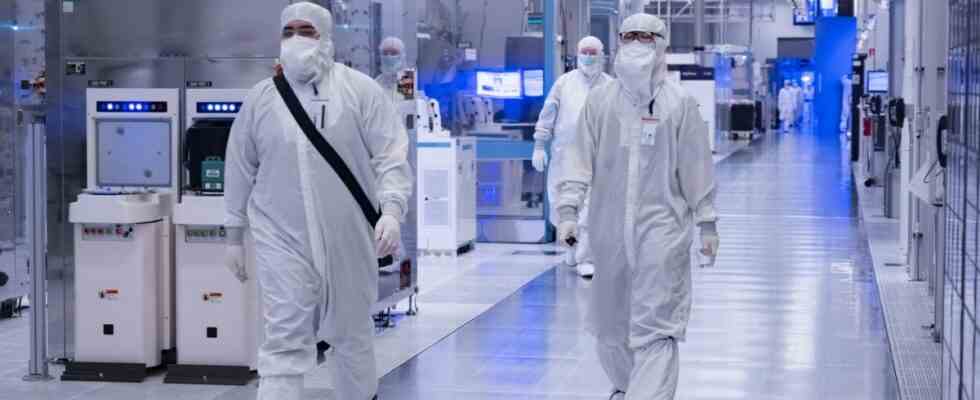At the end of his speech, Pat Gelsinger reaches up to the top of the shelf: “Today,” says the head of the chip manufacturer Intel, “today we are making history.” And Saxony-Anhalt’s Prime Minister Reiner Haseloff seems quite willing to agree. Intel’s decision to locate two ultra-modern chip factories in Magdeburg was ultimately “the largest investment in the history” of his country. So this Tuesday is official, what has long been speculated about, recently rumored more and more concretely: Germany will be the first location of Intel’s Europe initiative. This also includes locations in France, Italy, Poland and Spain.
EU Commission President Ursula von der Leyen praises Intel’s announcement as the first success of the EU Chip Act, which provides for projects in this sector to be funded both by the EU itself and by the member states. The industry also agreed with Intel’s decision. It is “good news if more semiconductor factories are built in Europe,” says Christian Hartel, CEO of Wacker Chemie, which also owns Siltronic, an important supplier to the chip industry. Hartel said more effort should have been put into attracting more chip companies a long time ago.
“As soon as possible” they want to get started in Magdeburg, says Intel’s top production manager Keyvan Esfarjan. One hopes for approval by the EU Commission. “If everything goes as planned”, construction could begin in the first half of 2023. That could take up to four years, and in 2027 the first chips from Magdeburg could be built into computers. Esfarjan is impressed by the selected location, as it offers all the prerequisites that are needed: energy, water and qualified workers. He emphasizes that 100 percent of the energy will come from renewable sources, and that overall more clean water will be released than is needed for production.
The Intel factory in Magdeburg should look like this computer graphic.
(Photo: Intel)
Intel itself will employ 3,000 people, plus another 10,000 from suppliers who will settle around the fabs, as the semiconductor factories are called in technical jargon. But other locations in Europe are not left empty-handed either. Italy gets a location where the finished chips are processed, which should create a total of 5000 jobs. In France, a large research and development area is to be built south of Paris, which will create a total of a thousand jobs. A new research laboratory is being set up in Poland, and cooperation with the Center for Supercomputing in Barcelona is being expanded in Spain.
Intel’s investment is particularly interesting for Europe because not only Intel semiconductors are to be manufactured there, i.e. usually high-performance chips, but because the group also wants to get more involved in contract manufacturing for other manufacturers who do not have their own manufacturing capacities . There is currently a lack of these capacities for manufacturing chips.
The result of this shortage has been the dictum of the “chip crisis” for more than a year: from toasters to luxury cars, today hardly any device works without chips, and certainly not a vehicle. It’s not so much about the high-performance processors that power laptops or smartphones, it’s about small semiconductor components that cost just a few cents and are lacking everywhere. Why cars and many other goods cannot be produced in the desired quantities.
But the missing production capacities cannot be built up that quickly, says the chip expert at the consulting firm Gartner, Alan Priestley. From the construction of a plant to the highly specialized machines costing up to $300 million each to the complex commissioning – it takes three to four years for a fab to be able to deliver in bulk. Existing fabs were also not so easy to expand.
When the logistics are jerky
There are also technical constraints. The older mass chips are produced on 200 millimeter wafers, i.e. the discs made of high-purity silicon that are supplied by specialized manufacturers such as Siltronic. However, the old factories for this have long since been written off, the profit margins are low, so there is not much incentive for the manufacturers to produce these cheap chips. In China, Priestley says, while factories would be built for these chips, they would be relied upon, but would become dependent again. One solution would be to switch to 300 millimeter wafers for the old chips as well. “But the wafer manufacturers have also invested too little in the past,” says Priestley.
Finally, there is the often jerky logistics. It also slows down the manufacturers. The main cause is the corona pandemic, which has disrupted supply chains worldwide. But chips were scarce even before Corona – simply because demand is increasing faster than manufacturers can add capacity. Due to the war in Ukraine, the neon gas that the chip industry needs for the manufacturing process is now running out because Russia and Ukraine are important suppliers – another stumbling block.
The competition also invests
Intel isn’t the only company to announce big investments in new manufacturing facilities. Competitor TSMC announced last year that it would invest around 100 billion dollars in the next three years, this year alone it should be 44 billion dollars. Samsung’s semiconductor division is also planning investments of 125 billion dollars by 2030. This is why we have heard from the industry that there could be a risk of overcapacity.
For the manufacturers that would be lossy, because: “A fab is a continuous process, if you turn it on, you have to go through it,” says chip expert Alan Priestley. But the market has always been cyclical. In addition, the companies could plan ahead and first have the buildings for the factories erected, which takes the longest, if there is a need then the machines can be procured and production ramped up.

